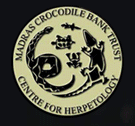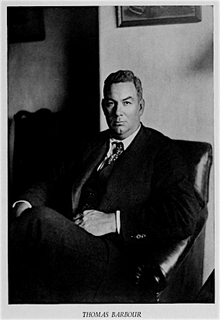Related Research Articles

Reptiles are tetrapod animals in the class Reptilia, comprising today's turtles, crocodilians, snakes, amphisbaenians, lizards, tuatara, and their extinct relatives. The study of these traditional reptile orders, historically combined with that of modern amphibians, is called herpetology.

Herpetology is the branch of zoology concerned with the study of amphibians and reptiles. Birds, which are cladistically included within Reptilia, are traditionally excluded here; the scientific study of birds is the subject of ornithology.

The Madras Crocodile Bank Trust and Centre for Herpetology (MCBT) is a reptile zoo and herpetology research station, located 40 kilometres (25 mi) south of the city of Chennai, in state of Tamil Nadu, India. The centre is both a registered trust and a recognized zoo under the Wildlife (Protection) Act, 1972 and comes under the purview of the Central Zoo Authority, Ministry of Environment and Forests, Government of India. It was established with the aim of saving three Indian endangered species of crocodile—the marsh or mugger crocodile, the saltwater crocodile, and the gharial, which at the time of founding of the trust were all nearing extinction.

Thomas Barbour was an American herpetologist. From 1927 until 1946, he was director of the Harvard Museum of Comparative Zoology (MCZ) founded in 1859 by Louis Agassiz at Harvard University in Cambridge, Massachusetts.

Live food is living food for carnivorous or omnivorous animals kept in captivity; in other words, small animals such as insects or mice fed to larger carnivorous or omnivorous species kept either in a zoo or as a pet.

Herping is the act of searching for amphibians or reptiles. The term, often used by professional and amateur herpetologists, comes from the word "herp", which comes from the same Greek root as herpetology, herpet-, meaning "creeping". The term herp is a shorthand used to refer to the two classes of ectothermic tetrapods.
Based in Irvine, California, Reptiles magazine is a North American magazine dedicated to the reptile and amphibian pet hobby, specializing in the keeping and breeding of these animals.
Clyde Peeling's Reptiland, which opened in 1964, is a zoo located in Allenwood, Pennsylvania and specializes in reptiles and amphibians. The zoo houses mambas, cobras, vipers, pythons and other snakes, as well as alligators, tortoises, lizards, and frogs. Reptiland has been an accredited member of the Association of Zoos and Aquariums (AZA) since 1986.

Nordens Ark is a zoo located on the 383-hectare (950-acre) Åby Manor in Bohuslän, Sweden. Nordens Ark was opened in 1989 and is operated by the Nordens Ark Foundation. Nordens Ark is on the west coast of Sweden, not far from the border with Norway. Victoria, Crown Princess of Sweden, was appointed as Nordens Ark Supreme Protector in 1989.
The Chennai Snake Park, officially the Chennai Snake Park Trust, is a not-for-profit NGO constituted in 1972 by herpetologist Romulus Whitaker and is India's first reptile park. Also known as the Guindy Snake Park, it is located next to the Children's Park in the Guindy National Park campus. Located on the former home of the Madras Crocodile Bank Trust, the park is home to a wide range of snakes such as adders, pythons, vipers, cobras and other reptiles. The park gained statutory recognition as a medium zoo from the Central Zoo Authority in 1995.
Wyoming is home to 12 amphibian species and 22 species of reptiles.
David G. Barker is an American herpetologist specialized in pythons and rattlesnakes.

Komodo Indonesian Fauna Museum and Reptile Park, is a zoological museum located within Taman Mini Indonesia Indah (TMII) compound, East Jakarta, Indonesia. The museum specialized on presenting various collection of the fauna of Indonesia, especially endemic animals of Indonesia, to provides information and education on Indonesian animal diversity. The Komodo Fauna Museum is located on southeast corner of Taman Mini Indonesia Indah cultural park.
References
- 1 2 3 4 "Gilroy, Calif., Reptile Store Thrives with Internet Site". McClatchy-Tribune Information Services. 30 January 2001. Archived from the original on 10 April 2016. Retrieved 6 June 2012.
- 1 2 3 4 5 6 7 Marech, Rona (16 June 2000). "Reptilian Rapture In Berkeley". SFGate. Retrieved 6 June 2012.
- 1 2 3 "East Bay Vivarium". Vacations. Disney. Retrieved 5 June 2012.
- ↑ "East Bay Vivarium". Berkeley Attractions. New York Times. Retrieved 5 June 2012.
- ↑ Yeung, Bernice. "Account May 26, 2010 Small Business Monthly » Buy Curious The Opportunity Fund Brings Microfinance to the East Bay". East Bay Express. Retrieved 5 June 2012.
- ↑ "Big Threat Exists for Small Businesses Seismic Resources". Knight Ridder Tribune. 26 May 2004. Archived from the original on 4 March 2016. Retrieved 6 June 2012.
- 1 2 Bhattacharjee, Riya. "Vivarium May Quit City Over Development, Parking Woes". Page One. The Berkeley Daily PLanet. Retrieved 7 June 2012.
- 1 2 Todd, Gail (16 Feb 2012). "Berkeley's shoreline: From reptiles to a park". SFGate. Retrieved 7 June 2012.